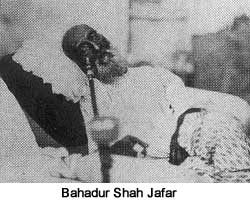

 |  |
 Before 1857 there had been a lot of armed uprising against the British rule, armed Sanyasis (Hindu Ascetics) of Bengal as well as various other small revolts led by small Kings, Farmers and Labourers took place from time to time but none had a true national character. These revolts did not had the true characteristics of a war, they were not organized and equipped to sustain enough to become a national struggle against foreign rule.
Before 1857 there had been a lot of armed uprising against the British rule, armed Sanyasis (Hindu Ascetics) of Bengal as well as various other small revolts led by small Kings, Farmers and Labourers took place from time to time but none had a true national character. These revolts did not had the true characteristics of a war, they were not organized and equipped to sustain enough to become a national struggle against foreign rule. Although the war of 1857 started with a rebellion in the British troops stationed in Meerut, but it soon spread like a wild fire in a large region of north India. The mutiny was a direct result of the various complaints which the common man had against the British misrule. Farmers were unhappy because of the land revenue policies of the British Government. They were losing hold over there lands. They were subjected to gross corruption and oppression by lower rank police as well as administrative officers. The upper & middle class was not happy with the British rule as they were not allowed to occupy any high post in the administration. The religious leaders such as Pandits & Maulvis were not happy with the British rule as they had lost royal patronage. Yet the real spark was flared by the British India Government's decision to annex Awadh in 1856. This left many a red faces both in Awadh and the British army, as the British army mainly consisted of men from the Awadh region. They were now forced to pay higher taxes for their land, as their families resided in Awadh. Also the Taluqdars and Jamindars (references for land holders) were also dead against the British rule as they had lost hold over their land, since they were all confiscated by the British India Government. British Governor General Lord Dalhousie's policy of Doctrine of Lapse had caused a lot of heartburn in the Indian royal arena. According to this policy all the Hindu kingdoms whose ruler died without a immediate heir would be annexed to the British India territories. They were not allowed to adopt a son. In this way by 1856 when Lord Dalhousie laid down his office and Canning took over as Governor General the British Empire in India extended to its natural boundaries - from Indus in the West to Irrawady (Burma) in the East and from Himalayas in the North to Cape Comorin (Kanya Kumari) in the far South. The displaced kings and their heirs were seeking revenge. Soon Nana Sahib of Bithoor, Rani of Jhansi Laxmi Bai and Mughal King Bahadur Shah Jafar all had turned against the British rule. Indian soldiers in the British Army were treated like an animal by their senior officers, they were less paid and overworked. A British observer of that time noted-"an Indian soldier is treated as a inferior creature. They are often referred as a Swine, paid less and an Indian cannot hope to go beyond the post of Subedar of 60-70 Indian rupees monthly fees." All these laid the foundation stone for a national uprising. But the final flare was ignited by the Enfield cartridge issue. Cartridges used in Enfield rifles had a paper made up off animal fat. Before using these cartridges one had to remove this paper with the teeth. The fat used in these papers were sometimes from Cows meat or from Pigs meat. Religious feelings of both Hindu as well as Muslim soldiers, in the British army, were badly hurt. They were ready to revolt, which gave other sections of the Indian society an perfect opportunity to rise in rebellion. next page >> |
Copyright ©2000 indiansaga.info. All rights reserved.
By using this service, you accept that you won't copy or use the data given in this website for any commercial purpose.
The material on indiansaga.info is for informational & educational purpose only.
This site is best viewed at 800 X 600 picture resolution.